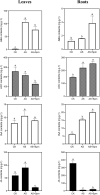Proteomic Responses to Alkali Stress in Oats and the Alleviatory Effects of Exogenous Spermine Application
- PMID: 33868329
- PMCID: PMC8049610
- DOI: 10.3389/fpls.2021.627129
Proteomic Responses to Alkali Stress in Oats and the Alleviatory Effects of Exogenous Spermine Application
Abstract
Alkali stress limits plant growth and yield more strongly than salt stress and can lead to the appearance of yellow leaves; however, the reasons remain unclear. In this study, we found that (1) the down-regulation of coproporphyrinogen III oxidase, protoporphyrinogen oxidase, and Pheophorbide a oxygenase in oats under alkali stress contributes to the appearance of yellow leaves (as assessed by proteome and western blot analyses). (2) Some oat proteins that are involved in the antioxidant system, root growth, and jasmonic acid (JA) and indole-3-acetic acid (IAA) synthesis are up-regulated in response to alkalinity and help increase alkali tolerance. (3) We added exogenous spermine to oat plants to improve their alkali tolerance, which resulted in higher chlorophyll contents and plant dry weights than in plants subjected to alkaline stress alone. This was due to up-regulation of chitinase and proteins related to chloroplast structure, root growth, and the antioxidant system. Spermine addition increased sucrose utilization efficiency, and promoted carbohydrate export from leaves to roots to increase energy storage in roots. Spermine addition also increased the IAA and JA contents required for root growth.
Keywords: alkali stress; carbohydrate; hormone; oat; proteome; spermine.
Copyright © 2021 Bai, Jin, Qin, Wang and Yin.
Conflict of interest statement
The authors declare that the research was conducted in the absence of any commercial or financial relationships that could be construed as a potential conflict of interest.
Figures





Similar articles
-
Metabolic and Physiological Changes in the Roots of Two Oat Cultivars in Response to Complex Saline-Alkali Stress.Front Plant Sci. 2022 Mar 29;13:835414. doi: 10.3389/fpls.2022.835414. eCollection 2022. Front Plant Sci. 2022. PMID: 35422836 Free PMC article.
-
Physiological and TMT-based proteomic analysis of oat early seedlings in response to alkali stress.J Proteomics. 2019 Feb 20;193:10-26. doi: 10.1016/j.jprot.2018.12.018. Epub 2018 Dec 18. J Proteomics. 2019. PMID: 30576833
-
Indole-3-acetic acid improves drought tolerance of white clover via activating auxin, abscisic acid and jasmonic acid related genes and inhibiting senescence genes.BMC Plant Biol. 2020 Apr 8;20(1):150. doi: 10.1186/s12870-020-02354-y. BMC Plant Biol. 2020. PMID: 32268884 Free PMC article.
-
Exogenous Dopamine Application Promotes Alkali Tolerance of Apple Seedlings.Plants (Basel). 2019 Dec 7;8(12):580. doi: 10.3390/plants8120580. Plants (Basel). 2019. PMID: 31817831 Free PMC article.
-
Silicon enhances the salt tolerance of cucumber through increasing polyamine accumulation and decreasing oxidative damage.Ecotoxicol Environ Saf. 2019 Mar;169:8-17. doi: 10.1016/j.ecoenv.2018.10.105. Epub 2018 Nov 6. Ecotoxicol Environ Saf. 2019. PMID: 30412897
Cited by
-
Mechanistic Insights into Vegetable Color Stability: Discoloration Pathways and Emerging Protective Strategies.Foods. 2025 Jun 24;14(13):2222. doi: 10.3390/foods14132222. Foods. 2025. PMID: 40646975 Free PMC article. Review.
-
Effect of the Interaction between Elevated Carbon Dioxide and Iron Limitation on Proteomic Profiling of Soybean.Int J Mol Sci. 2022 Nov 7;23(21):13632. doi: 10.3390/ijms232113632. Int J Mol Sci. 2022. PMID: 36362418 Free PMC article.
-
Integrative transcriptome and metabolome analysis reveals the mechanism of fulvic acid alleviating drought stress in oat.Front Plant Sci. 2024 Sep 19;15:1439747. doi: 10.3389/fpls.2024.1439747. eCollection 2024. Front Plant Sci. 2024. PMID: 39363917 Free PMC article.
-
Responses of growth and photosynthesis to alkaline stress in three willow species.Sci Rep. 2024 Jun 25;14(1):14672. doi: 10.1038/s41598-024-65004-5. Sci Rep. 2024. PMID: 38918471 Free PMC article.
-
Metabolic and Physiological Changes in the Roots of Two Oat Cultivars in Response to Complex Saline-Alkali Stress.Front Plant Sci. 2022 Mar 29;13:835414. doi: 10.3389/fpls.2022.835414. eCollection 2022. Front Plant Sci. 2022. PMID: 35422836 Free PMC article.
References
-
- Bai J. H., Liu J. H., Zhang N., Yang J. H., Sa R. L., Wu L. (2013). Effect of alkali stress on soluble sugar, antioxidant enzymes and yield of oat. J. Integr. Agric. 12 1441–1449. 10.1016/S2095-3119(13)60556-0 - DOI
LinkOut - more resources
Full Text Sources
Other Literature Sources

